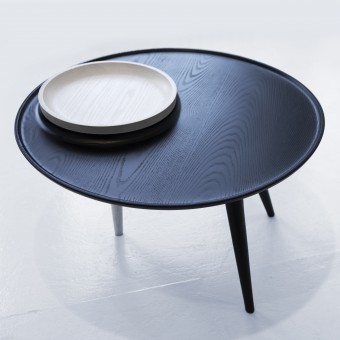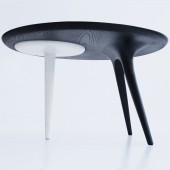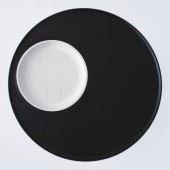
| THE AWARD |
| CATEGORIES |
| REGISTRATION |
| SUBMIT YOUR WORK |
| ENTRY INSTRUCTIONS |
| TERMS & CONDITIONS |
| PUBLICATIONS |
| DATES & FEES |
| METHODOLOGY |
| CONTACT |
| WINNERS |
| PRESS ROOM |
| GET INVOLVED |
| DESIGN PRIZE |
| DESIGN STORE |
| THE AWARD | JURY | CATEGORIES | REGISTRATION | PRESS | WINNERS | PUBLICATIONS | ENTRY INSTRUCTIONS |
Codependent Table by Fletcher Eshbaugh |
Home > Winners > Design #104539 >Interview |
 |
|
FS: What is the main principle, idea and inspiration behind your design?
FE: Psychology is the basis for the table, and the specific condition is codependency. This is the first of many projects that will focus on what I refer to as "Anima-Forma" or a physical representation of a psychological condition.
FS: What has been your main focus in designing this work? Especially what did you want to achieve?
FE: I wanted to achieve awareness for mental health as it is something that I feel is important. I also wanted to blur the line between art and commercial enterprise and this was the perfect vehicle for both.
FS: What are your future plans for this award winning design?
FE: I am looking into sort of a tiered offering for clients by adjusting the design / materials / processes, and as well I am expanding the "Anima-Forma" series which I am working on now.
FS: How long did it take you to design this particular concept?
FE: I think the idea was quick, but to get the form right I went through a few months of designs and refinements until I settled upon this final direction.
FS: Why did you design this particular concept? Was this design commissioned or did you decide to pursuit an inspiration?
FE: This was something on my own that I believed in, and wanted a signature piece for my venture 1th Studio to offer. It was a chance to do something with limited constraint about something I was passionate about so it was a super exiting project to fulfill.
FS: Is your design being produced or used by another company, or do you plan to sell or lease the production rights or do you intent to produce your work yourself?
FE: Codependent is in limited production that I 100% control myself, so that is satisfying but I haven't ruled out a partnership for this or future work in the series.
FS: What made you design this particular type of work?
FE: Passion for both design and psychology.
FS: Where there any other designs and/or designers that helped the influence the design of your work?
FE: I think that there has been such a richness of interesting furniture design out there, it's hard to say that one influence in particular pushed me in this direction. I think there was definitely a need for this type of project to come from me and it wasn't absolutely known until I started working through the idea.
FS: Who is the target customer for his design?
FE: This piece is certainly high-end, but I designed it for anyone that appreciates design and is looking for a story to go along with the work.
FS: What sets this design apart from other similar or resembling concepts?
FE: I think that there have been plenty of designs that have incorporated psychology covertly-in fact all design does. What I was trying to do though, was to bring the idea of psychology as an overt part of the product, to have them both lead the product rather than as a footnote.
FS: How did you come up with the name for this design? What does it mean?
FE: The name is derived from the condition of codependency, and it means "excessive emotional or psychological reliance on a partner" essentially.
FS: Which design tools did you use when you were working on this project?
FE: Pen and paper, Adobe Illustrator and Photoshop, Fusion 360, and Solidworks.
FS: What is the most unique aspect of your design?
FE: The concept and the form are both intertwined so I would say they both define the design collectively.
FS: Who did you collaborate with for this design? Did you work with people with technical / specialized skills?
FE: I initially bounced my work off of one of my colleagues and initially consulted an engineer to cross-check the design as a second set of eyes. During the prototyping phase I worked with a master woodworker and we built the prototype over a period of time.
FS: What is the role of technology in this particular design?
FE: The design was definitely refined in 3D software and I 3D printed a scale model before making the full size prototype. Other than that it was artisanal in nature, but the entirety of the design lends itself to being almost totally fabricated by machine.
FS: Is your design influenced by data or analytical research in any way? What kind of research did you conduct for making this design?
FE: Psychology is a life long interest of mine, and my father is a practicing psychologist so I absolutely worked with him on some of the conceptual aspects of this design, as well as some research conducted by myself to really familiarize myself with the features of the condition.
FS: What are some of the challenges you faced during the design/realization of your concept?
FE: Really the biggest constraint was allocating enough time to producing the prototype once we got the design. I ended up being very busy and to work and oversee given my schedule was very demanding.
FS: How did you decide to submit your design to an international design competition?
FE: I am very proud of this work, and I think that it speaks to both psychology and design in a meaningful way. I also see this as a defining moment in what can be done between the realms of art and commercial enterprise.
FS: What did you learn or how did you improve yourself during the designing of this work?
FE: I learned to practice patience in a serious way during the design of this work. I think there were many challenges but without that patience I don't think that things would have turned out nearly as well.
FS: Any other things you would like to cover that have not been covered in these questions?
FE: Just that I am thrilled to have won a Gold A'design Award for my work, and I am looking forward to showcasing more from the "Anima-Forma" line in the near future!
FS: Thank you for providing us with this opportunity to interview you.
A' Design Award and Competitions grants rights to press members and bloggers to use parts of this interview. This interview is provided as it is; DesignPRWire and A' Design Award and Competitions cannot be held responsible for the answers given by participating designers.
| SOCIAL |
| + Add to Likes / Favorites | Send to My Email | Comment | View Press-Release | Translations |




